

مجلة النفط والتعاون العربي
161
العدد
- 2017
أربعون
المجلد الثالث و ال
2016
أوابك العلمية لعام
�
ص لبحوث العلمية الفائزة بجائزة
�
عدد خا
78
68
Table (13) shows global base oil refining capacity
103
in various regions of the
world, which is much higher than the demand projections provided above. In a
January 2016 article about ICIS lube conference in Dubai
42
, it was suggested that
base oil facilities were operating at 65% of capacity in 2015 and that the surplus
capacity stood at 19 million tons a year. The surplus is forecast to grow to about
22 million tons a year by 2020. The new capacity additions in groups II and III
are about 7.5 million tons a year by adding up the new capacities between 2013
and 2016 only
37
. Some rationalization is expected especially in phasing out group
I capacities but the fact remains that surplus capacity is going to weigh on the
market and this does not bode well for the re-refining industry.
Table (13)
Global Base Oil Refining Capacity 2014 - 1000 barrels/day*
Group I Group
II
Group
III
Naphthenic
TOTAL
Additions
2014 -
2015**
North America
75.0
157.8
2.0
48.1
282.9
2.4
Western Europe
113.6
5.5
8.6
10.4
138.1
14.0
Central & Eastern
Europe
86.0
1.4
2.6
0.0
90.0
7.0
S.Asia/Pacific/Australia
63.7
46.8
16.0
0.0
126.5
5.2
Middle East & Africa
68.9
6.0
30.2
0.0
97.1
11.0
China
39.5
68.6
7.0
23.7
138.8
34.3
Japan & Korea
32.5
60.3
50.9
3.6
147.3
13.0
TOTAL
479.1
346.3
117.3
85.8
1020.6
86.9
TOTAL Million tons a
year
24.4
17.7
6.0
4.4
52.1
4.4
* Includes only solvent extraction and hydro-finished re-refining capacity
** This list is not exhaustive and there could be more
Source: (103) Lubes'N'Greases 2014 Guide to Global Base Oil Refineries
The Impact of Process Selection:
Process selection by itself depends on many factors and not just economic. Is the
project in a country with a good and well controlled collection system? Are the
laws and regulations supportive of a re-refining project? Apart from the used oil
feed, are other raw materials available or not? Is the project inside or close to a
petroleum refinery where exchange of materials, reduction of safety and security
cost is possible? This is particularly important with respect to hydrogen supply if
the selected process is of the hydro-treating type. How big is the re-refining
project under consideration? To start with it should be as big as the collection
system can support in a sustainable manner. At the same time some processes are
suitable for large plants and others for small plants. The modern plants which
produce good quality hydro-finished oils are much more economical than small
plants of the same technology.
















